The unions, which contest the reform of the calculation of unemployment benefit which entered into force on October 1, play Monday, November 15, with limited hope, their last card before the Council of State. The highest administrative court will examine the appeal
"on the merits"
of the unions before rendering its decision in the following weeks. But the rejection at the end of October of their emergency appeal had the effect of a cold shower.
"We will play the game to the end but we are very optimistic
,
"
concedes CGT negotiator on unemployment insurance Denis Gravouil.
“I still believe in it otherwise I wouldn't be a trade unionist. But I'm much less enthusiastic than the first time, ”
admits his FO counterpart Michel Beaugas.
To discover
Energy check: all you need to know about the aid scheme which concerns nearly 5.8 million households
Prime Macron 2021: how does it work?
Read alsoIs unemployment really at its lowest for almost 15 years?
In his decision, the summary judge took note of the improvement in employment which no longer constituted
"an obstacle to the implementation of the reform"
, contrary to what he had said in June when the government wanted to apply on July 1 the new calculation rules.
This decision does not commit the Council of State on the merits, but
"it does not like to annul a decision which requires recalculations"
, fears Michel Beaugas, the first allocations according to the new calculation having been distributed at the beginning. November.
At the heart of the dispute, the new method of calculating the daily reference wage (SJR), the basis of unemployment benefit, which will penalize the compensation of job seekers alternating periods of work and inactivity.
In a context of difficulties in recruiting companies, President Emmanuel Macron judged in his speech on Tuesday this reform
"essential (...) to make the return to work more attractive in all cases"
, the previous rules may make example more remunerative this “permittence” that an activity continues part-time for the same number of hours worked.
Read alsoThe good hiring dynamics are confirmed and amplified
To remedy this, the 2019 reform provided that the SJR be calculated by dividing the wages received during the 24 months before unemployment by all the days - and no longer the only days worked - between the first and the last day of unemployment. 'use. Mechanically, this greatly reduces the amount of the allowance (since we divide the same salary by more days) of those who do not work continuously. But the Council of State invalidated this measure in November 2020 on the grounds that it resulted in
"a manifestly disproportionate difference in treatment"
between the unemployed.
To mitigate it, the executive has capped the number of non-working days taken into account, but the unions will try to convince judges to the contrary through practical cases. In addition, they are based on an assessment by Unédic dating from April according to which up to 1.15 million people opening rights in the year following the entry into force of the reform would receive a more monthly allowance. low (17% on average), with at the same time an
extended
“theoretical duration of compensation”
(14 months on average compared to 11). The Ministry of Labor vigorously contests this figure which does not take into account the improvement in the economic situation since nor "
behavioral effects"
hoped for from the reform.
Read also Employment at its highest, labor shortages too
The other major argument of the unions remains the gap between the entry into force of the new calculation method and that of the bonus-malus on companies (in seven major sectors consuming short contracts) which will have no effect on contributions. unemployment only in September 2022. The executive, which is counting on this measure to fight against the abuse of precarious contracts, responds that the
“observation period”
of companies to calculate this modulation started in July 2021.
Finally, the unions estimate that the lower expenditure due to the reform (1.9 billion in 2022, including 800 million linked to the SJR, according to Unédic) goes beyond the savings initially desired by the government (between 1 and 1, 3 billion).
The rest of the contested reform, which has passed the Council of State stage, will apply on December 1.
You will have to have worked six months instead of four to receive unemployment benefit.
The 30% degression (for unemployed people under 57 years of age who have lost earnings above 4,500 euros gross) will apply to the 7th month and no longer to the 9th.

